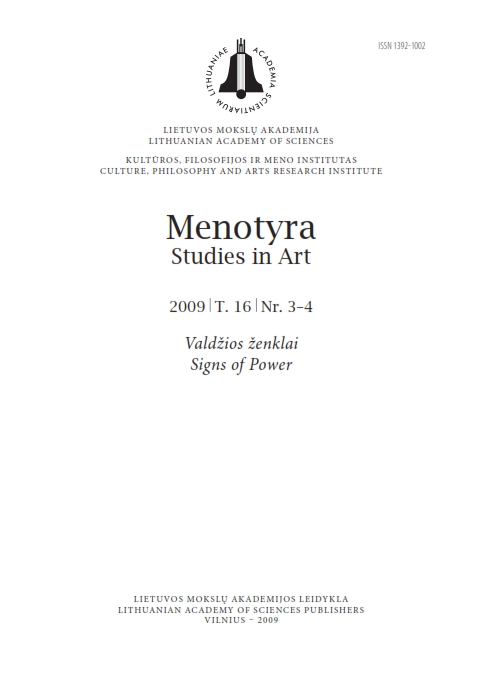Lietuva 1939–1944 m.: valdžios ženklai
Lithuania in 1939–1944: signs of power
Author(s): Giedrė JankevičiūtėSubject(s): Visual Arts, Politics and society, WW II and following years (1940 - 1949)
Published by: Lietuvos mokslų akademijos leidykla
Keywords: art and politics; occupation and culture; signs of power; public spaces; visual ideology;
Summary/Abstract: The article explores the use of symbolic artefacts for political representation, which ex-pressed changes of power in Lithuania during 1939–1944, i. e. annexation of Klaipėda by Nazi troops in March 1939, incorporation of Vilnius into the territory of the Lithuanian Republic in October of the same year, the first Soviet occupation which lasted from June of 1940 to June 1941, and finally the German occupation.One of the goals of the present research was to show a large variety of the means and ways of symbolic remaking of public spaces, including not only the change of state symbols, destruction of old and construction of new monuments, set design of propaganda events and other typical “local” actions of establishing the new power, but also the “mo-bile” devices of visual ideology. While seeking to establish to what extent visual ideology was effective and how it changed the perception and identity of people, the author of the article uses examples of not only visual art in the strictest sense, but also visual culture in general, comprising also various forms of “high” artistic culture, i.e. works of art and architecture and images created by artists, which enjoyed mass distribution – press illustrations, posters and other works of applied graphic art (letterheads, lottery tickets, postage stamps) with a large print-run, set design of festive events and state symbols (coats-of-arms, flags).Attention is focused on the symbols of establishing the new power. The expression of the idea of Lithuanian statehood in the works of architecture and art created during World War II is also analyzed. The author shows how the German civil government manipulated the symbols of independent Lithuania for their own ends; in other words, how the symbols of Lithuanian statehood were banned, but the expression of Lithuanian nationality was supported and even encouraged to a certain level.The article ends with a conclusion that it is possible to interpret the processes and artefacts of Lithuanian art in 1939–1944 only through a complex analysis of images of the period, as art was involved in the space of political acting. Visual ideology formed the environment of daily life, changed the perception of social and cultural reality, and influenced artistic creation and its reception. The analysis of images allows us to establish the place of art in society’s life, to explain the distribution of art forms and genres (the meaning and abundance of graphic art in the Soviet period, the thriving of the portrait and landscape genres and the marginalization of sculpture in the years of Nazi occupation), and to explore the relation of local culture with the forms and themes of imported culture instilled by the occupants.
Journal: Menotyra
- Issue Year: 16/2009
- Issue No: 3-4
- Page Range: 130-149
- Page Count: 20
- Language: Lithuanian

